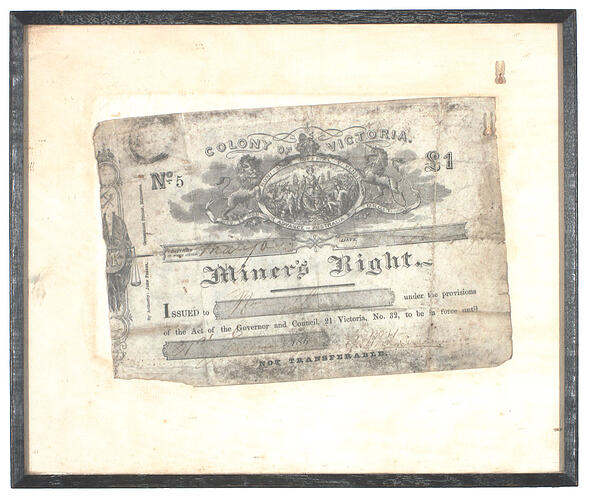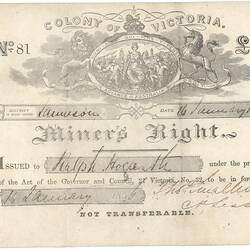Summary
Miner's Right, issued to a miner at Maryborough, Victoria, possibly in February 1865. The licence, printed on paper, is in poor condition. It cost one pound, and licenced a prospector to mine for gold or other minerals for a certain period of time. It was Not Transferable. It has been filled out in ink, but most of the writing has faded and is now illegible. There are handwritten notes in faded ink on the back.
Physical Description
Miner's Right, or licence, issued to a miner at Maryborough, Victoria, possibly in February 1864. The licence, printed on paper, is in poor condition. It cost one pound, and licenced a prospector to mine for gold or other minerals for a certain period of time. It was Not Transferable. It has been filled out in ink, but most of the writing has faded and is now illegible. There are handwritten notes in faded ink on the back. The Miner's Right was printed 'By Authority: John Ferres, Government Printer, Melbourne'. On the left margin is an etching of an early Victorian coat of arms (kangaroo on left, emu on right, with shield between); a crossed pick and shovel; crossed flags above 'VR' and the Scales of Justice, and scroll work. (At some stage the document has been trimmed to fit, so this etching has been trimmed.) At the top of the licence is an elaborate etching, under the heading 'Colony of Victoria'. Within a shield is an image of a young woman in classical dress, seated, with shipping in the background; on her left is a miner with hat presenting her with a gold nugget; on her right, a farmer presents grain to her. Mottoes include 'Honi Soit Que Mal Y Pense'; 'Dieu et Mon Droit' and 'Advance Australia'. Production Methods: pulped; printed; framed.
Significance
The Eureka Rebellion in December 1854 was sparked in part by what miners felt was an unreasonable officiousness of police and inspectors who carried out fortnightly checks on the fields to ensure that all miners had an expensive gold licence. After the Rebellion, the gold licence was abolished and replaced by a miner's right costing one pound per year. Possession of this gave the digger a right to mine gold, and vote in the elections for parliament. This example, produced in the 1860s, is an elaborate document, presumably made so to prevent forgery.
More Information
-
Collecting Areas
-
Acquisition Information
Collected
-
Place & Date Issued
Maryborough, Victoria, Australia, 01 Feb 1865
Date and name of person issued to is somewhat indecipherable. -
Printer
John Ferres, Government Printer, Melbourne, Victoria, Australia, circa 1860
-
Place & Date Used
-
Inscriptions
'Colony of Victoria/ No. 5/ 1 [pound]/ Honi Soit Que Mal Y Pense'; 'Dieu et Mon Droit' 'Advance Australia'/ By Authority: John Ferres, Government Printer, Melbourne/ District in which Issued: Maryborough [handwritten] / Date [Illegible., possibly 1 Feby. / Miner's Right/ Issued to [handwritten, mostly Illegible. Mr ..../ under the provisions of the Act of the Governor and Council, 21 Victoria, No. 32, to be in force until /[handwritten: 31st January 186[5?]./ Signature illegible. / Not Transferable. On back, pencil and ink marks, including what appears to be a list of jurors. Legible names include Robert, John (?) and Charlotte.
-
Classification
-
Category
-
Discipline
-
Type of item
-
overall dimensions
28.5 cm (Length), 1.5 cm (Width), 24 cm (Height)
-
Exhibition Collection Management
28.5 mm (Length), 1.5 mm (Width), 24 mm (Height)
-
Dimensions
200 mm (Length), 136 mm (Width)
Measurement From Conservation.
-
Dimensions
200 mm (Length), 136 mm (Width)
Measurement From Conservation.
-
Keywords
Alluvial Gold Mining, Economic Geology, Gold, Gold Mining, Goldfields, Licences, Mineral Exploration, Miners' Rights, Mining Regulations, Prospecting




